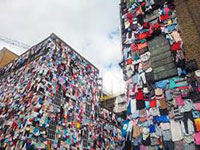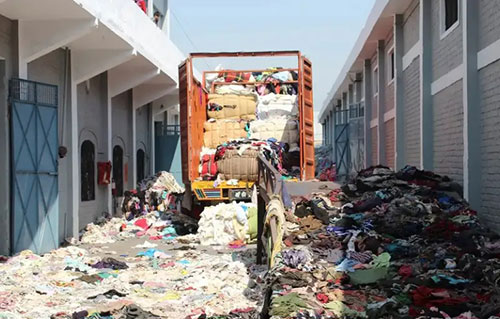"Even though in the Global Fashion Agenda, sustainability has been this season’s must have accessory, almost half of fashion industry is yet to take any action on it. The term has been reduced to self-serving market jargon used by brands to perk up sales. As Orsola de Castro, Co-Founder of Fashion Revolution notes, big brands usually associate th2e word ‘sustainability’ with something unobtainable. However, smaller labels and independent designers are effectively creating their garments in the most conscious way."
 Even though in the Global Fashion Agenda, sustainability has been this season’s must have accessory, almost half of fashion industry is yet to take any action on it. The term has been reduced to self-serving market jargon used by brands to perk up sales. As Orsola de Castro, Co-Founder of Fashion Revolution notes, big brands usually associate th2e word ‘sustainability’ with something unobtainable. However, smaller labels and independent designers are effectively creating their garments in the most conscious way. The key to their success is their consideration for the environment, believes Clair Bergkamp, Head of Sustainability and Innovation at Stella McCartney. She advises brands to incorporate sustainability right from the inception of their operations.
Even though in the Global Fashion Agenda, sustainability has been this season’s must have accessory, almost half of fashion industry is yet to take any action on it. The term has been reduced to self-serving market jargon used by brands to perk up sales. As Orsola de Castro, Co-Founder of Fashion Revolution notes, big brands usually associate th2e word ‘sustainability’ with something unobtainable. However, smaller labels and independent designers are effectively creating their garments in the most conscious way. The key to their success is their consideration for the environment, believes Clair Bergkamp, Head of Sustainability and Innovation at Stella McCartney. She advises brands to incorporate sustainability right from the inception of their operations.
Environmentalist advice focus on organic and recycled materials
Few leading designers are embracing sustainability by using recycled materials and deadstock fabrics. For instance, womenswear designer Richard Malone works with nylon recycled from ocean plastics. Designer Bethany Williams sources her recycled denim from a waste depository in Kent and turns waste paper into woven textiles. Dutch designer Duran Lantink splices second-hand designer clothes into mash-up hybrids. Phoebe English sources all her organic recycled materials from Britain to reduce carbon footprint, while Stella McCartney recycled deadstock from previous collections into an entirely new one at Paris Fashion Week this season.
instance, womenswear designer Richard Malone works with nylon recycled from ocean plastics. Designer Bethany Williams sources her recycled denim from a waste depository in Kent and turns waste paper into woven textiles. Dutch designer Duran Lantink splices second-hand designer clothes into mash-up hybrids. Phoebe English sources all her organic recycled materials from Britain to reduce carbon footprint, while Stella McCartney recycled deadstock from previous collections into an entirely new one at Paris Fashion Week this season.
Bergkamp further advises these brands to focus on their fabrics, use organic cotton, recycled polyester and nylon, chose a viscose supplier that can guarantee they do not destroy ancient and endangered forests for their fibre, use hemp and linen and don’t use leather.
Independent suppliers, plant-based materials to deal with sustainability
One of the biggest issues the fashion industry faces in implementing sustainability is the arcane supply chain that is difficult to trace. To deal with this, new platforms such as the Open Apparel Registry are emerging to map out garment factories across the globe to encourage consumer transparency. Designers are also working with independent suppliers who are controlling their environmental impact. Richard Malone, for instance, uses plant-based dyes for his fabrics, many of which are recycled and made by a community of women who dye all the yarn, spin and hand-weave the fabric in Tamil Nadu.
According to Francois Sourchet, Head, Make Fashion Circular campaign, another method through which brands can reduce wastes is through repairing, customising, swapping, donating or resale. He believes if the clothing has been made from safe and renewable materials, and designed to be recycled, it can feed back into the system and be used to make new clothing.
New e-com channels and partnerships
The internet offers lots of information on the source of these clothes. De Castro believes consumers need to patiently go through this information, to read between the lines, and question everything, and then rely on their gut instincts to discern what feels relevant. Many companies are developing plant-based materials as an alternative to animal products. One such company Bolt Threads makes silk from protein, created using fermentation, and leather made from mycelium, the root structure of mushrooms.
For many, sustainability starts with limiting their production and building meaningful relationships with retailers and individual clients. This may also include working outside of the conventional fashion calendar, or simply partnering with recycled textile suppliers and designing smaller collections around those materials that are available. To achieve this, brands may have to ask their customers to wait longer for their clothes or make clothes only when required. They need to also employ the most appropriate business besides entering into new partnerships and collaborations. Only then, their goal of sustainability can be achieved.












